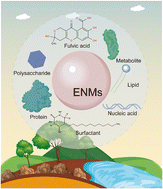Nano–eco interactions: a crucial principle for nanotoxicity evaluation
Abstract
Engineered nanomaterials (ENMs) have excellent physical and chemical properties and are widely synthesized and utilized in industry and daily life, but this results in the introduction of large quantities of ENMs into the ecosystem. The adsorption of a variety of biomolecules within the eco-system onto the surface of ENMs forms the eco-corona, or bio-corona. The formation of environmental coronas dramatically alters the physical, chemical, and biological characteristics of ENMs and thus influences their behavior and fate. Moreover, the physicochemical properties of ENMs affect their interaction with biological fluids directly or indirectly after entering the biosystem and determine the biotransformation, biodistribution, and bioavailability of ENMs, especially with protein corona (PC) formation in plasma. Many recent studies have focused on ENM–protein interactions to avoid challenges regarding technical feasibility and sample availability; fewer studies have focused on nano–eco interactions. This review summarizes interactions between ENMs and environmental biomolecules, and characterization methods, with in-depth discussions of nano–eco interactions that dictate ENM fate and the rational design of better-adapted and less toxic ENMs, thereby offering a new perspective on biosafety evaluation for ENMs.

- This article is part of the themed collection: Environmental Science: Nano Recent Review Articles


 Please wait while we load your content...
Please wait while we load your content...